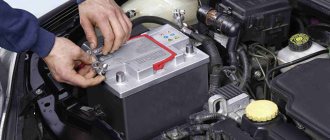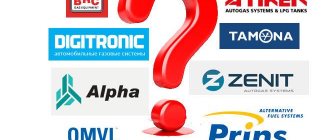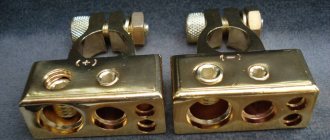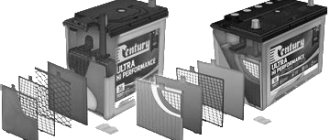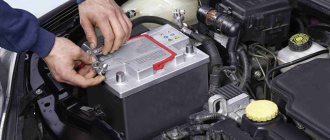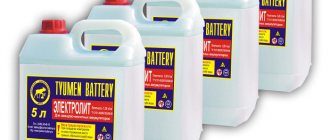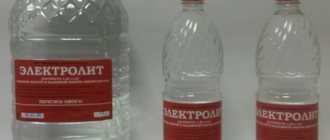Explanation of the names of GEL and AGM batteries
GEL stands for Gelled Electrolite. The electrolyte is an acid bound with a stabilizer called silica gel. Silica gel in jelly form is located between the metal plates. Due to the fact that silica gel actually occupies all the empty space between the metal plates, drying and shedding of the plates becomes impossible.
AGM stands for Absorption Glass Matt. Translated from English - “absorbent glass mats”. In fact, it is a special fiberglass impregnated with electrolyte and located between lead plates. Due to the fact that the electrolyte is located in the pores of the fiberglass, AGM batteries can be used in any position and are safe to use.
Difference between EFB and AGM
AGM and EFB technologies are similar, the main difference is the electrolyte used. In the first case, liquid is used, fiberglass acts as an envelope. This option doesn't work out at all.
In the EFB it is also liquid; when shaking, you can even hear it flop, but there is much less of it, and the plates are wrapped more tightly. The electrochemical fluid is not sealed inside the fiberglass. We can say that EFB technology is a cross between conventional batteries and AGM.
Structural differences include:
- The thickness of the plate is greater, which means the operating time increases.
- With less electrolyte and the use of purified lead, the charge accumulates by 45%.
- EFB will cost less than AGM. However, the latter have better characteristics, as proven by alphaline batteries.
Production technology of GEL and AGM batteries
Batteries made using AGM technology and batteries made using GEL technology have a number of advantages over conventional lead-acid batteries. The main difference between GEL and AGM batteries from traditional ones is that they do not contain liquid electrolyte.
In GEL batteries, the active acid is bound with a special substance - silica gel. In such batteries, the electrolyte is brought to the state of a thick mass, that is, a gel. The gel electrolyte often contains silicic acid, sulfuric acid and special additives - stabilizers.
In AGM batteries, liquid acid impregnates special porous glass wool mats. Thus, the electrolyte itself is located in the pores of the mats. That is, it is not present in free liquid form. Acid mats are placed between metal plates.
The design of GEL and AGM provides the main consumer advantages of AGM and GEL batteries:
- do not require maintenance or topping up electrolyte;
- relatively safe even if the case is damaged;
- do not emit fumes, can even be installed in a living room;
- low self-discharge - only 2% per month (at a temperature of 20C).
AGM technology
If you haven’t clicked on the link at the top yet (and you shouldn’t), then read here. AGM is a battery built on so-called absorbent glass mats, many believe that it is just fiberglass - maybe so, but manufacturers keep its secret secret.
The whole point is that this fiberglass holds the electrolyte inside, does not allow it to evaporate and spread, but impregnates the lead plates with the necessary electrolyte. By the way, the plates are arranged quite tightly in such batteries; there are fiberglass mats between them, this increases the battery capacity . Due to the fact that the electrolyte is locked inside, the battery can be placed on any side, but there is a small limitation - you cannot place it upside down.
The plates are made of pure lead (highly purified), so the electrical resistance inside is low, which allows the battery to be charged quickly and discharged quickly - producing very high currents.
I would like to note that these are maintenance-free batteries; when charged, they do not emit evaporation (neither oxygen nor hydrogen), which makes them 100% safe - they can even be used inside a car, as well as inside the house, for alternative systems (solar, wind).
The service life compared to conventional types is approximately doubled, from 5 to 10 years. It is worth noting the resistance to deep discharges. These batteries are capable of withstanding 190-210 discharge cycles “to zero” (100%), up to 340 at 50% and up to 850 at 30%. These are quite high figures, and if the discharge is at the level of 20%, then this battery may not feel it at all; it is not advisable to drain ordinary batteries by 15% of their capacity.
It feels especially good during winter periods, since currents it can simultaneously deliver are 2-3 times higher than those of conventional batteries (can reach 900A), and therefore almost any serviceable engine will start in cold weather. By the way, how to charge them correctly, read here .
Comparison of characteristics of GEL and AGM batteries
AGM batteries are more reliable in operation. When the electrolyte in such batteries is heated, there is virtually no risk of severe swelling and explosion. The same cannot be said about GEL batteries; when boiling, large bubbles can form in such batteries, which pose a real danger.
GEL batteries were designed by order of the military departments and were primarily to be used in aircraft. Such batteries can continue to function even if they are hit by a bullet. Since the electrolyte is in a gel state, it does not spill out, and the battery continues to provide energy. GEL batteries are highly efficient.
When designing batteries using AGM technology, designers again began to use liquid acid. Now the acid is in special thin plates or mats consisting of a porous substance. At the same time, the pores themselves are not filled completely, leaving room for the movement of gases. When AGM batteries operate, gases are released, but remain in the free pores of the plates. This technology allows the use of AGM batteries in various places without the need for vertical placement.
AGM and GEL batteries are very resistant to deep discharges; this technology significantly increases the service life of the battery. At the same time, even with a deep discharge, the battery continues to produce electricity. AGM and GEL batteries can withstand a large number of complete charge and discharge cycles. The average number of cycles allowed is approximately 600 cycles. Some batteries built using GEL technology can withstand up to 1000 charge and discharge cycles. This significantly increases the life of the battery in real conditions.
AGM and GEL batteries have low self-discharge, which makes it possible to store a charged battery for a long time, up to one year. At the same time, the charge does not decrease significantly.
The service life of a good battery made using AGM and GEL technology reaches up to five to ten years, depending on operating conditions.
An important indicator is the cost of batteries. In the production of GEL batteries, expensive electrodes made of extremely pure lead are used; the electrolyte contains highly purified sulfuric acid. For this reason, the cost of GEL batteries is higher than AGM batteries.
AGM batteries
The operating principle of AGM batteries is the same as the two previous types. The main difference is in the design of the separators and the state of the electrolyte. Between the lead plates there is fiberglass, which is impregnated with electrolyte. AGM stands for Absorbed Glass Mat or Absorbed Glass Fiber. Only pure lead is also used for the plates.
The fiberglass and the plates are pressed tightly against each other. The electrolyte is retained due to the porosity of the material. Low resistance is created, which affects the charging speed and high current during return.
Such batteries are also considered maintenance-free batteries. Sulfation occurs slowly, the plates do not crumble. The electrolyte does not flow and practically does not evaporate. Excess gases are released through special valves.
AGM battery with cylindrical compartments
Another feature of AGM batteries is the ability to twist the plates into rolls or spirals. Each compartment has the shape of a cylinder. This allows for a larger interaction area and improved vibration resistance. Batteries in this design can be seen from the well-known brand OPTIMA.
Advantages and disadvantages
AGM batteries can be used and stored in any position. The housing is sealed. You only need to monitor the charge level and the condition of the terminals. The device can be stored for 3 years, losing only 15-20% of its charge per year.
Such batteries deliver high starting currents up to 1000A. This is several times higher than usual.
Full discharges are not scary. The battery can withstand 200 discharges below zero, up to 500 discharges at half and 1000 discharges at 30%.
AGM batteries perform better than all others at low temperatures. Even in severe frost, the performance is not reduced. They also tolerate high temperatures up to 60-70°C.
Like gel batteries, AGMs are sensitive to charging. A slight excess of current damages the battery. Above 15V is already critical. Also, short circuits must not be allowed. Therefore, you should always use a special charger.
AGM batteries cost several times more than regular batteries, even more than gel ones.
Advantages of GEL batteries in comparison
GEL batteries have the following advantages:
- withstand a large number of charge-discharge cycles;
- completely restore capacity after a deep discharge;
- less sensitive to “bad” charge from an unstable network;
- withstands discharge from an undercharged state without loss of capacity;
- can operate in cyclic mode;
- They tolerate work better in both cold and high temperatures;
- Thermal breakdowns between the plates are practically eliminated.
How to charge AGM batteries
Here we come to the extremely important issue of the charging process, which determines how long the device can last.
It is allowed to charge the mechanism with a slightly higher current than 10% of the total battery capacity. However, in no case can it be more than 20%.
In the process of producing battery plates, very high-quality lead is used, so charging takes no more than a few hours.
Professionals recommend the following forms of charge:
- three-stage (one of the best);
- main two-stage;
- accelerated single-stage charge.
Advantages of AGM batteries in comparison
AGM batteries have the following advantages:
- with equal capacity they are approximately 10-15% cheaper than gel ones;
- withstand a large number of charge-discharge cycles;
- work better for discharge with high currents;
- higher maximum charge speed (6-8 hours AGM versus 8-10 hours GEL);
- more practical to use;
- safer in conditions of electrolyte overheating;
- easier to produce and do not require the use of particularly pure materials.
Depending on the specific model and design of the batteries, characteristics and properties may vary. Below is another independent comparison of GEL and AGM batteries.
Some figures may vary between different models from different manufacturers. Time moves forward, battery manufacturers are constantly improving the design and consumer properties of batteries.
Review of AGM batteries from different manufacturers: characteristics, prices, differences
Today, batteries using AGM technology can be found literally everywhere. They are used on assembly lines to equip cars equipped with a start-stop system. They operate barriers, blinds and gates. Thanks to rechargeable batteries, neon advertisements and road signs on highways glow at night. Let us add that AGM technology is recognized as optimal in batteries of power plants operating on energy sources such as the sun, wind and waves. Beyond competition, the advantages of AGM also turned out to be in uninterruptible power supplies for computers. Currently, almost all well-known global brands have devoted significant parts of their production volumes to AGM batteries. These are BOSCH, and Optima, and Tudor, and Medalist and others. Below, for comparison, are several popular models of car batteries with AGM technology and their characteristics.
| Brand | Country of origin | Capacity | Weight | Approximate price | Life time |
| A*h | kg | rub. | years | ||
| Haze HZB12-28 AGM | China-UK | 28 | 16 | 4300 | 5 |
| VOSTOK SK-1255 | Russia | 55 | 16 | 6200 | 5 |
| DEKA | USA | 32 | 10 | 7000 | 7 |
| TOPLA | Slovenia | 60 | 15 | 9500 | 8 |
| VARTA D52 | Germany | 60 | 16 | 10700 | 10 |
Table 1. Comparative review of AGM batteries
It is gratifying that recently Russian-made batteries have become increasingly common in ratings of the top companies in the use of AGM technology in batteries. In addition to markings indicating the type of battery, you can often see on battery cases: VRLA (Valve Regulated Lead Acid batteries) or SLA (Sealed Lead Acid batteries). These inscriptions are required according to international safety standards.
The first abbreviation is usually placed on batteries with a capacity of over 30 Ah and indicates that the device is equipped with a safety valve. The second marking is placed on low-capacity AGM batteries (up to 30 Ah). The presence of a bypass is due to the inevitable release of hydrogen during recharging. When the value reaches 100 millibars, the valve opens and releases gas into the atmosphere, thereby relieving the pressure to a safe level.
